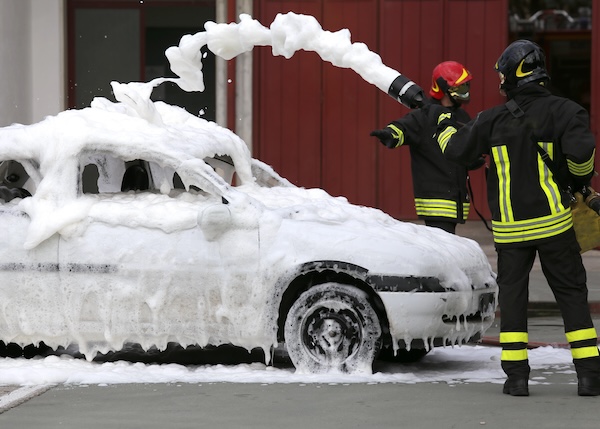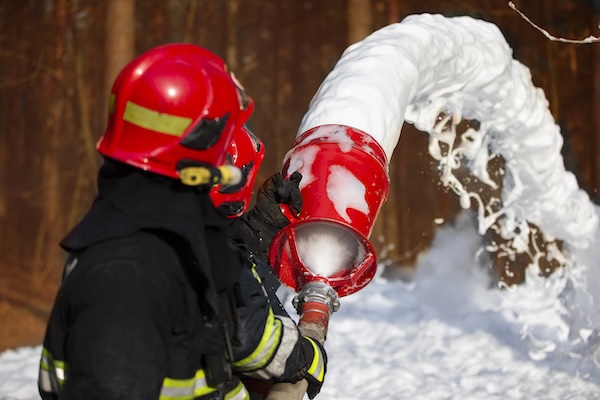Dangers To Water Providers and the Environment
Another significant concern associated with AFFF is its potential to contaminate water sources and pose risks to water providers and the environment.
The PFAS chemicals present in this toxic foam can leach into the groundwater and contaminate drinking sources, posing a significant threat to human health.
One example of the environmental dangers posed by AFFF is the contamination of groundwater near military bases and airports. In several instances, the use of AFFF during firefighting training exercises resulted in the release of PFAS chemicals, often referred to as “forever chemicals,” into the environment, leading to long-term contamination of water sources.
These contaminated water supplies not only affect local communities but, depending on the level of the contamination and the flow of groundwater, can also expand to contaminate much larger areas.
The potential risks to water providers and the environment highlight the urgent need for preventive measures and responsible actions by manufacturers. We must prioritize the development and use of safer alternatives to AFFF to minimize the environmental impact and protect water sources from contamination.
Legal Processes and Personal Injury Claims
In response to the harm caused by AFFF foam products, legal processes have been initiated to hold manufacturers accountable. Lawsuits and personal injury claims are being pursued by individuals and communities affected by the health and environmental consequences of AFFF exposure.
Manufacturers of aqueous film-forming foam are accused of knowing about the harmful effects of their products but failing to provide adequate warnings or take appropriate action to protect the public.
These lawsuits aim to hold the manufacturers accountable and seek compensation for medical expenses, lost wages, and pain and suffering, among other damages.
Tyco, 3M, and Dupont are among the manufacturers facing personal injury claims related to AFFF firefighting foam.
The legal processes surrounding AFFF litigation are complex and involve multiple parties, including plaintiffs, defendants, and legal experts. Still, these personal injury claims and lawsuits are important to pursue, as they are a means for affected individuals and communities to seek justice and hold manufacturers accountable for the harm caused by their AFFF products.
These legal processes also raise important questions about the regulation and oversight of firefighting foam products and the role of government agencies in ensuring public safety.
Parties Involved in AFFF Firefighting Foam Lawsuits
Lawyers across the country are representing individuals filing AFFF firefighting foam lawsuits.
These lawsuits aim to hold the manufacturers and distributors of AFFF products accountable for any harm caused by their products. The parties involved include the plaintiffs, who have been exposed to AFFF and developed cancer, and the defendants, who are the manufacturers and distributors of AFFF products.
The plaintiffs’ legal representation consists of experienced attorneys who specialize in personal injury and product liability cases. These attorneys work to gather evidence, build a strong case, and seek compensation for their clients.
The defendants, on the other hand, are represented by their own legal teams, who defend their clients against the allegations of negligence and seek to minimize their liability.
Court-appointed mediators play a crucial role in settlement talks as well, helping with negotiations between the parties and assisting them in reaching a resolution. The mediator is a neutral third party who’s there to help find common ground and a fair settlement.
Mediators are especially important in complex cases like AFFF lawsuits, where multiple plaintiffs and defendants are involved, and the stakes are high.
Through the legal process, individuals who have been exposed to AFFF and developed cancer can seek compensation for their injuries and hold the responsible parties liable for their actions.
Resolutions, Bans, Settlements, and Lawsuits
As the harmful effects of AFFF have become more widely recognized, various resolutions, bans, settlements, and lawsuits have emerged to address the issue, provide remedies and preventive measures, and to mitigate the ongoing harm caused by AFFF products.
For example, cases related to AFFF firefighting foam are pending in the South Carolina court, where affected individuals and communities are seeking compensation for health issues and environmental contamination caused by these toxic foam products.
Additionally, there have been bans on PFAS-containing firefighting foams in Colorado, highlighting the recognition of the potential risks associated with these products. Settlements have also been reached in some cases, where manufacturers have agreed to provide financial compensation to affected individuals and implement measures to prevent further harm.
These resolutions, bans, settlements, and lawsuits reflect the growing awareness of the harmful effects of AFFF firefighting foam and the need for action to protect public health and the environment.
Holding Manufacturers Accountable for Harmful AFFF Products
It’s crucial to hold manufacturers accountable for the harm caused by AFFF products.
These ongoing legal processes, including lawsuits and personal injury claims, play a vital role in seeking justice for those affected by the harmful effects of AFFF firefighting foam. Continued attention and efforts are equally necessary to address the issues related to AFFF and ensure the future safety of both individuals and the environment.
Manufacturers have a responsibility to prioritize safety and take action in light of the evidence of harm caused by their products. Additionally, government agencies play a crucial role in regulating and overseeing the use of firefighting foams to protect public health and the environment.
Moving forward, it’s essential to continue research on safer alternatives to AFFF-containing products and invest in technologies that can effectively suppress fires without the harmful effects of PFAS chemicals.
By working together, manufacturers, regulators, and communities can strive to prevent further harm and ensure a safer future for ourselves, our families, and our environment.
If you, or someone you know, has been exposed to AFFF products resulting in illness, or you have any questions about South Carolina AFFF firefighting foam lawsuits, please contact us today to discuss your legal rights.










